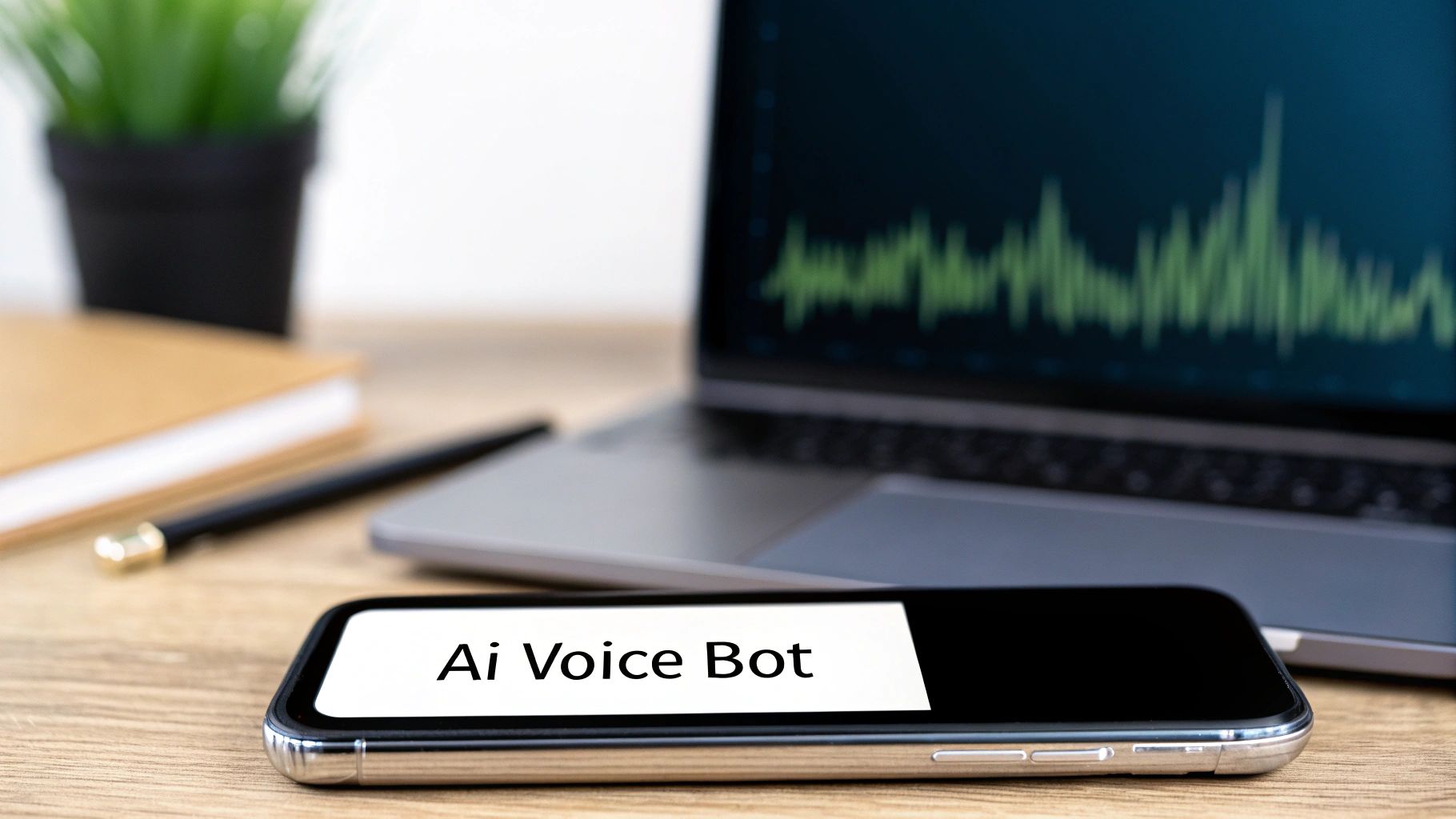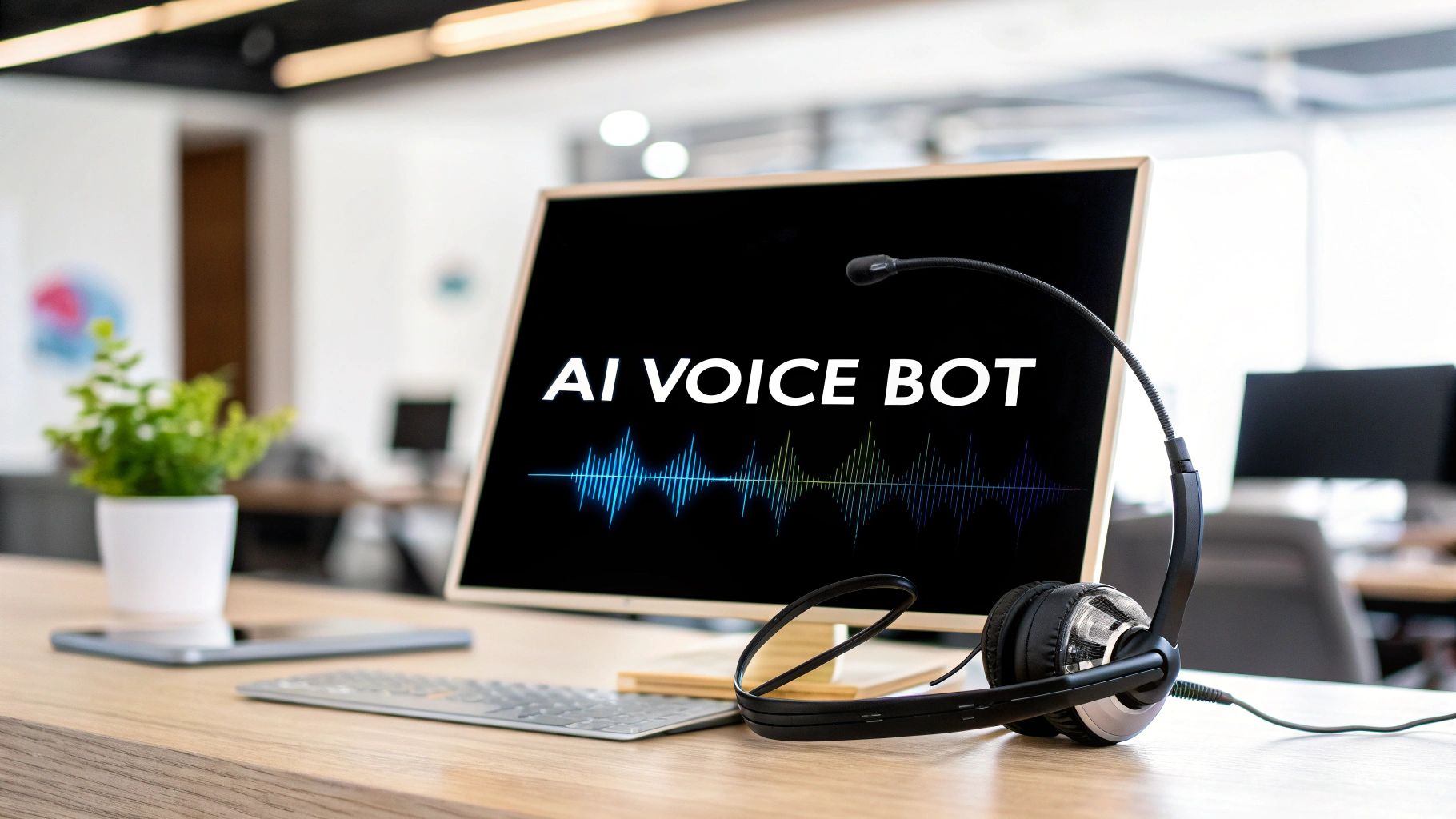At its core, an AI voice bot is a smart program that uses conversational AI to understand what someone is saying over the phone, figure out what they need, and hold a natural, two-way conversation to help them. Forget those rigid, old-school phone menus. Think of it as a truly capable assistant.
What Is an AI Voice Bot and Why Does It Matter?
Imagine your customer service working like a smart GPS. When a customer calls, it doesn't just offer a list of options; it instantly understands where they're trying to go and calculates the quickest, most efficient route to get them there. That’s the real difference between a modern AI voice bot and the frustrating phone trees of the past. It moves beyond "Press 1 for sales, press 2 for support" into the realm of genuine, helpful dialogue.

This technology marks a significant shift in how we approach customer engagement, moving away from one-way commands and toward dynamic, responsive conversations. To really get a handle on this, it's worth understanding what Voice AI is and how it's transforming communication at a foundational level.
The Next Generation of Customer Interaction
The whole point of an AI voice bot is to solve problems through conversation. Instead of forcing callers down a narrow, pre-set path, it actually listens, understands the context of the conversation, and provides a direct answer or completes the required task. This is a game-changer for businesses that want to provide excellent service without burning out their human agents. You can see more practical applications in our guide on AI calling.
The importance of this isn't just talk; the market growth tells the story. In the MEA region alone, the trend is impossible to ignore.
Valued at USD 213.1 million in 2024, the AI agents market is expected to skyrocket to around USD 2.2 billion by 2030. That’s a staggering compound annual growth rate (CAGR) of 48.3%, fueled by the widespread adoption of AI in major industries.
This incredible growth highlights just how much value businesses are getting from automating their voice interactions in a smarter way.
From Rigid Menus to Intelligent Dialogue
The best way to appreciate this leap forward is to compare the old guard with the new. We’ve all been frustrated by traditional Interactive Voice Response (IVR) systems. An AI voice bot, on the other hand, is engineered from the ground up for customer satisfaction.
Here’s a quick breakdown of how they stack up:
Traditional IVR vs Modern AI Voice Bot
| Feature | Traditional IVR | AI Voice Bot |
|---|---|---|
| Input Method | Touch-tone (DTMF) only | Natural language speech |
| Understanding | Follows rigid, pre-defined menus | Understands intent, context, and nuance |
| Flexibility | Zero deviation from the script | Adapts to the caller's needs in real-time |
| Problem Solving | Limited to routing and basic info | Can handle complex queries and transactions |
| Customer Experience | Often frustrating and impersonal | Conversational and engaging |
| Integration | Basic CRM lookups | Deep integration with multiple systems |
This isn't just a technological upgrade; it's about fundamentally improving customer relationships through more effective and empathetic communication. An AI voice bot doesn't just field a request—it understands it and resolves it, turning every call into a more productive and positive experience.
How an AI Voice Bot Actually Works
Ever wonder what’s happening under the hood when you talk to an AI voice bot? It's not just a simple recording playing back. Think of it as a lightning-fast, three-part symphony where your spoken words are the opening notes, and a helpful, spoken answer is the finale. This whole process, from you speaking to the bot replying, happens in just a few seconds.
First, the bot has to "hear" you. This is where a technology called Automatic Speech Recognition (ASR) comes in. ASR acts like the bot’s digital ears, with one critical job: to listen to the sound of your voice and convert it into written text. This initial translation from speech to text is the foundation for everything that follows.
This diagram shows how a customer's request travels through the system, from their voice to the AI's response.

As you can see, it's a smooth cycle: capture the speech, process the meaning, and deliver a spoken reply. This creates a natural back-and-forth conversation.
The AI Brain at Work
Once your words are in text form, the bot's "brain" kicks into gear. The magic here is driven by Natural Language Processing (NLP), which gives the bot the power to truly understand what you're saying. NLP isn't just about recognizing words; it’s about figuring out your intent.
For example, NLP can tell the difference between "I need to see my account balance" and "I want to update my billing address," even if you use slang, have an accent, or don't speak perfectly clearly. It’s this ability to grasp the goal of the call that sets modern AI apart. More sophisticated bots can even use sentiment analysis to detect if a caller is happy, frustrated, or confused.
The real smarts of an AI voice bot isn't just in transcribing words. It's in understanding context, intent, and nuance. That's what separates it from the rigid, frustrating automated menus of the past.
With this understanding, the AI decides what to do next. It might pull up your account info from a CRM, kick off a transaction, or ask a follow-up question if it needs more information to get the job done right.
Crafting the Perfect Response
The final piece of the puzzle is giving the bot its "voice," which is handled by Text-to-Speech (TTS) technology. Once the AI brain figures out the right answer and puts it into text, the TTS engine takes over, converting that text back into natural-sounding speech.
Today’s TTS engines are incredibly sophisticated. They aren't the monotone, robotic voices you might be thinking of. Modern systems can provide:
- A choice of voices and accents to match a company's brand personality.
- Variable pacing and intonation, making the speech sound more dynamic and human.
- Clear pronunciation of tricky names, technical terms, or long strings of numbers.
This final step completes the conversation, delivering a response that is not only accurate but also easy to understand. The entire cycle—ASR, NLP, and TTS—is executed almost instantly, creating the smooth, helpful interaction that customers now expect.
Key Features Your AI Voice Bot Needs to Succeed
Let's be honest: not all AI voice bots are built the same. If you want to move past a clunky, automated phone menu and see a real return on your investment, you need a solution with the right set of features. These are the capabilities that make the difference between a frustrated customer and a genuinely satisfied one.
When you're looking at different options, think of it less like buying a single tool and more like building an intelligent system. The features need to work together seamlessly.

Here are the non-negotiables that define a truly successful AI voice deployment.
Core Capabilities for Modern Voice AI
A great AI voice bot is so much more than just a voice. It has to be woven into the fabric of your entire customer service operation. Prioritize these core features:
-
Omnichannel Consistency: Customers live across multiple channels. They might start a conversation on your web chat and then call in later. Your AI bot must keep up, maintaining context so people never have to repeat their story. It’s a simple concept, but it's fundamental to a good experience.
-
Advanced Sentiment Analysis: This is a big one. The bot needs to understand how a customer is feeling—are they frustrated, confused, or happy? This allows it to adjust its tone or, crucially, recognize when it's time to hand the conversation over to a human agent who can provide a more empathetic ear.
-
Robust Systems Integration: For a bot to be genuinely useful, it can't be siloed. It needs deep, direct connections to your business software. Think of integrations with your CRM (like Salesforce or HubSpot), helpdesk platforms, and ERP systems. This is what allows the bot to perform meaningful tasks like updating an account, checking an order status, or even processing a payment.
-
24/7 Availability: This is perhaps the most obvious, but also one of the most powerful, benefits. Offering instant support around the clock isn't just a convenience; it's a game-changer for customer satisfaction. It means help is there when they need it, not just when you're open.
This always-on support model is a major reason for the technology's rapid adoption. The global voice assistant market, a core component of this tech, was valued at USD 5.2 billion in 2023 and is expected to surge to USD 25.3 billion by 2032. In regions like the MEA, the demand for bots that can handle both Arabic and English highlights a clear consumer shift toward convenient, hands-free service. You can dig deeper into this growth in a detailed voice assistant market report.
An AI voice bot without deep CRM integration is like a receptionist without access to the company directory. It can answer the phone, but it can't truly help anyone.
Choosing the right AI voice bot really comes down to focusing on these practical, powerful features. They are what will turn your investment into tangible improvements, building a smarter, more responsive contact center.
When you look past the technology itself, the real value of an AI voice bot shows up on your balance sheet and in your customer satisfaction scores. The impact isn't just a minor improvement; it ripples across your entire operation, creating a powerful return on investment that fundamentally changes what your contact center can achieve.
It all starts with a massive boost in operational efficiency. Think about the sheer volume of repetitive calls your team fields every single day—simple things like order status updates, appointment changes, or basic account questions. A voice bot handles these instantly, 24/7, without a single error. This frees your expert human agents to pour their energy into the complex, sensitive, and high-value conversations where their skills truly make a difference.
This shift isn't just about making life easier for your agents. It directly translates into major cost savings and smarter resource management. Instead of constantly hiring to keep up with call volumes, you have a single AI assistant that can scale up or down on a dime, handling peak hours or overnight inquiries without ever getting tired.
A Better Experience for Your Customers
But efficiency gains are only part of the equation. An AI voice bot also delivers a dramatically better customer experience (CX). We all know how frustrating it is to be stuck on hold. In a world where we expect instant answers, long queues are a surefire way to lose customers. Voice bots eliminate that frustration entirely by offering immediate, consistent service.
This "always-on" support is exactly what modern customers expect. It doesn’t matter if they call at 2 PM on a Tuesday or 2 AM on a Sunday; they get the same reliable, high-quality interaction. The bot becomes a dependable first point of contact, making your business feel more accessible and responsive, which is a huge driver for loyalty.
Turning Conversations into Strategy
The final, and perhaps most strategic, benefit is the treasure trove of data-driven insights a voice bot uncovers. Every single call is a piece of intelligence. By analyzing what customers are saying, you can pinpoint:
- Common Pain Points: What are the most frequent problems people call about? This is your roadmap for proactive fixes.
- Emerging Trends: Are customers suddenly asking about a competitor's new product or a service you don't offer yet?
- Process Gaps: Where in your IVR or online checkout do people get stuck and decide to call?
This kind of feedback is gold. It allows you to refine your products, streamline your processes, and build a better customer journey based on what people are actually experiencing, not just what you assume they want.
Bringing an AI voice bot into your contact center isn't just a tech upgrade. It's a strategic move that simultaneously cuts costs, makes customers happier, and gives you the hard data you need to grow smarter.
Adoption is accelerating, especially in regions like the Middle East and Africa. In 2024, the MEA AI assistant software market hit roughly USD 598.7 million in revenue, and it's projected to soar to USD 2.15 billion by 2033. You can dig deeper into these figures and explore detailed AI market insights on Grand View Research. This explosive growth underscores a clear shift: businesses are no longer just experimenting with AI; they're using it to gain a real, measurable advantage.
Your Roadmap to a Successful AI Voice Bot Launch

Rolling out an AI voice bot isn't just about plugging in new software; it's a strategic move that needs to be planned with care. Getting it right from the start means having a clear roadmap that connects the technology directly to your business goals. Let's walk through the essential steps to make your launch a success.
Before you even think about the tech, you need to define what success looks like. What problem are you actually trying to solve? Are you looking to slash customer wait times, bring down operational costs, or finally offer genuine 24/7 support? Pinpointing these goals and setting clear metrics upfront will be your north star for every decision that follows.
Identifying High-Impact Use Cases
With your objectives set, it's time to figure out where the bot can make the biggest difference, fast. Don't try to automate everything at once. Instead, look for the low-hanging fruit: the high-volume, repetitive tasks that bog down your team. Nailing these "quick wins" proves the concept and builds momentum for the entire project.
Some great places to start often include:
- Order Status Inquiries: These are simple, data-driven questions that a bot can handle flawlessly.
- Appointment Scheduling and Reminders: A structured, predictable process that’s perfect for automation.
- Basic Account Questions: Fielding common queries like, "What's my current balance?" frees up agents for more complex issues.
- Frequently Asked Questions: Let the bot tackle the common informational questions that don't require a human touch.
By focusing on these areas first, you can demonstrate the value of your AI voice bot with minimal risk.
A successful deployment starts small. Think of it as a pilot project. For instance, DoorDash successfully automated support for its delivery drivers by first focusing on their most common questions, fielding hundreds of thousands of calls and providing answers in 2.5 seconds or less.
Designing and Training Your Bot
Once you’ve picked your starting points, the real design work begins. This is where you map out conversation flows that feel natural and helpful, not robotic and frustrating. A crucial piece of this puzzle is creating a seamless handoff to a human agent. You must have a graceful exit ramp for when a conversation gets too complex or a customer simply wants to talk to a person.
Training the bot is an ongoing commitment that requires high-quality data. You’ll feed it real-world call transcripts and articles from your knowledge base so it can learn your company's unique language and accurately grasp what customers want. It’s a continuous cycle of learning—the bot gets smarter with every call it handles.
For a deeper look into the components that make these conversations possible, explore our guide on AI conversational IVR. By following a structured roadmap, you can sidestep the common pitfalls and launch an AI voice bot that delivers real, lasting value from day one.
The Future of AI Voice in Customer Engagement
Looking ahead, the journey of the AI voice bot is only just beginning. We're on the cusp of a major shift, moving from bots that simply react to problems to ones that intelligently anticipate them. Picture this: a voice bot that analyzes a customer's account history, sees a potential billing issue, and proactively reaches out with a solution before the customer even thinks to call.
This isn't just about answering questions better; it's about crafting deeply personal interactions on a massive scale. Future bots won't just pull up an account number. They'll understand a customer's past purchases, their preferences, and even their sentiment to steer the conversation with genuine awareness. This is where we're headed: emotionally intelligent AI.
Towards More Human Interactions
The technology is getting frighteningly good at mimicking human nuance. We're seeing bots that can adjust their tone, speed, and word choice on the fly, all based on the caller's emotional cues. An upset customer might be greeted with a calm, patient voice, while someone asking for store hours gets a quick, no-nonsense answer. This kind of dynamic response is what will finally blur the line between talking to a machine and a truly helpful human.
But it doesn't stop there. When you combine voice AI with other technologies like augmented reality (AR), the possibilities get really interesting. Imagine a field technician getting step-by-step, voice-guided repair instructions through their smart glasses. Or a shopper taking a voice-led virtual tour of a new car from their living room. These aren't just minor tweaks; they're the building blocks for the next generation of customer experience.
The goal is no longer just about automating away tasks. It’s about building real, lasting connections. The AI voice bot is evolving into a true partner in the customer journey, one that actively strengthens the relationship, not just processes the transaction.
As these systems become more woven into the fabric of a business, their impact will be felt far beyond the contact center. To see how this fits into the bigger picture, it's worth exploring the business process automation benefits that this technology unlocks. An AI voice bot isn't just a tool for today; it's a foundational piece of future business strategy and customer loyalty.
Have Questions About AI Voice Bots? We've Got Answers.
Bringing any new technology into your contact center is a big decision, and it naturally comes with a lot of questions. When it comes to AI voice bots, you need clear, straightforward answers to feel confident you're making the right move. Let's tackle some of the most common things business leaders ask.
The first question is almost always about how this technology is really different from what they already have. It's a great question, because at first glance, the lines can seem a bit blurry.
How Is This Different from IVR or a Chatbot?
Many people wonder if an AI voice bot is just a fancier version of a traditional IVR system or a spoken version of a text chatbot. While they all fall under the umbrella of automation, their capabilities are worlds apart.
Think of an old-school IVR as a rigid, one-way street. It forces callers down a frustrating path of "Press 1 for sales, Press 2 for support." A chatbot is better, but it's still stuck on a screen.
An AI voice bot is the intelligent next step. It uses sophisticated Natural Language Processing (NLP) to understand what a person is actually saying—intent, context, and all. This completely gets rid of the need for those restrictive menus, allowing for a much more natural and effective conversation.
The real difference isn't just the technology—it's the experience. An AI voice bot is built to understand and resolve a caller's issue, not just route their call. This focus on resolution is what turns it from a simple tool into a genuine strategic asset.
Another major consideration, especially when customer information is involved, is security.
How Secure Are They, and How Do They Work with My Team?
Can you really trust an AI voice bot with sensitive data? The answer is a firm yes, provided you work with the right platform. Enterprise-grade AI voice bots are built with security as a core foundation, not an afterthought.
They use critical technologies like data encryption and content redaction to automatically protect personal details and payment information. When you're evaluating a provider, always confirm they are compliant with standards like PCI-DSS to ensure your customer data is locked down tight.
Finally, the big one: Will this technology replace my human agents? This is a common worry, but the answer is a definitive no. The goal is to augment your team, not replace it.
It's all about creating a powerful partnership. The AI voice bot handles the high-volume, repetitive queries that come in 24/7. This frees your skilled agents to focus their time and expertise on the complex, high-value, and emotionally sensitive customer issues that truly require a human touch. The result is a more efficient operation and, just as importantly, higher job satisfaction for your team.
Ready to see how a secure, intelligent AI voice bot can elevate your customer conversations? Cloud Move delivers customized contact center solutions that integrate seamlessly with your existing CRM and business tools. Schedule your free demo today!




